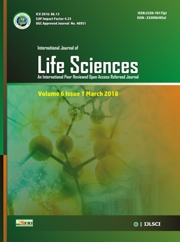RESEARCH ARTICLES
Volume 9 |Issue 1| January-February 2021 First published: 28 February 2021
Study on biosurfactant production by beneficial lactic acid bacteria isolated from traditionally fermented Indian foods
Ghume Vaishnavi, Shingade Shilpa , Walhe Rajan*
Department of Microbiology, Abasaheb Garware College, Pune,
*Corresponding Author: Walhe Rajan, Associate Professor and Head, Department of microbiology, MES’ Abasaheb Garware College, Pune (India). E-mail: rawalhe@rediffmail.com
Abstract
Keywords:Fermented foods, Lactic acid bacteria, BSH activity, Biosurfactants, Probiotics
Editor: Dr.Arvind Chavhan
Cite this article as:
Ghume Vaishnavi, Shingade Shilpa, Walhe Rajan. Study on biosurfactant production by beneficial lactic acid bacteria isolated from traditionally fermented Indian foods., Int. Res. Journal of Science & Engineering, 2021, Volume 9(1): 5-11.
References
1. Azam M, Mohsin M, Ijaz H, Tulain UR, Ashraf M A, Fayyaz A. Lactic acid bacteria in traditional fermented Asian foods. Pak. J. Pharm. Sci., 2017; 30 (5): 1803-1814.
2. Satish Kumar R, Kanmani P, Yuvaraj N, Paari K A, Pattukumar V, Arul V. Traditional Indian fermented foods: a rich source of lactic acid bacteria. International Journal of Food Sciences and Nutrition, 2013: 64(4): 415–428. https://doi.org/10.3109/09637486.2012.746288.
3. Harzallah D, Belhadj H. Lactic Acid Bacteria as Probiotics: Characteristics, Selection Criteria and Role in Immunomodulation of Human GI Muccosal Barrier. In J. M. Kongo (Ed.): Lactic Acid Bacteria - R & D for Food, Health and Livestock Purposes. In Tech. 2013; pp: 197-216. https://doi.org/10.5772/50732.
4. Ghasemi A, Moosavi-Nasab M, Setoodeh P, Mesbahi G, Yousefi G. Biosurfactant Production by Lactic Acid Bacterium Pediococcus dextrinicus SHU1593 Grown on Different Carbon Sources: Strain Screening Followed by Product Characterization. Scientific Reports, 2019. 9(1). https://doi.org/10.1038/s41598-019-41589-0. Science, 2011, 1–9. https://doi.org/10.1155/2011/201254.
5. Hill C, Guarner F, Reid G, Gibson GR, Merenstein DJ, Pot B, Morell, L, Canani RB, Flint H J, Salminen S, Calder PC, Sanders ME. The International Scientific Association for Probiotics and Prebiotics consensus statement on the scope and appropriate use of the term probiotic. Nature Reviews Gastroenterology & Hepatology,2014; 11(8): 506–514. https://doi.org/10.1038/nrgastro.2014.66.
6. Arshad FA, Mehmood R, Hussain S, Annus Khan M, Khan MS. Lactobacilli as Probiotics and their Isolation from Different Sources. British Journal of Research;05(03).1-11: https://doi.org/10.21767/2394-3718.100043.
7. Mulaw G, Tessema ST, Muleta D, Tesfaye A. In Vitro Evaluation of Probiotic Properties of Lactic Acid Bacteria Isolated from Some Traditionally Fermented Ethiopian Food Products. International Journal of Microbiology, 2019: 1–11. https://doi.org/10.1155/2019/7179514.
8. Behzadnia A, Moosavi-Nasab M, Tiwari BK, Setoodeh P. Lactobacillus plantarum-derived biosurfactant: Ultrasound-induced production and characterization. Ultrasonics Sonochemistry, 2020; 65, 105037. https://doi.org/10.1016/j.ultsonch.2020.105037.
9. Satpute SK, Kulkarni GR, Banpurkar AG, Banat IM, Mone NS, Patil, RH,Cameotra SS. Biosurfactant/s from Lactobacilli species: Properties, challenges and potential biomedical applications: Biosurfactant/s from Lactobacilli species. Journal of Basic Microbiology, 2016; 56(11): 1140–1158. https://doi.org/10.1002/jobm.201600143.
10. Kaur S, Kaur P, Nagpal R. In Vitro Biosurfactant Production and Biofilm Inhibition By Lactic Acid Bacteria Isolated From Fermented Food Products. International Journal of Probiotics and Prebiotics, 2015; 10 (1):17-22.
11. Tillawala MH, Shah MN. Screening and Characterisation of Biosurfactant Producing Lactic Acid Bacteria. International Journal of Science and Research, 2018; 7 (3): 1626-1630.
12. Hosseini SV, Arlindo S, Böhme K, Fernández-NC, Calo-Mata P, Barros-Velázquez, J. Molecular and probiotic characterization of bacteriocin-producing Enterococcus faecium strains isolated from nonfermented animal foods: Probiotic E. faecium strains. Journal of Applied Microbiology, 2009; 107(4): 1392–1403. https://doi.org/10.1111/j.1365-2672.2009.04327.x.
13. Singhal K, Joshi H, Chaudhary BL . Bile and acid tolerance ability of probiotic Lactobacillus strains. Journal of Global Pharma Technology, 2010; 2(12):17-25.
14. Wang SC, Chang CK,Chan SC, Shieh JS, Chiu CK, Duh PD. Effects of lactic acid bacteria isolated from fermented mustard on lowering cholesterol. Asian Pacific Journal of Tropical Biomedicine, 2014: 4(7): 523–528. https://doi.org/10.12980/APJTB.4.201414B54.
15. Kunzes AK, Bhalla TC.In vitro cholesterol assimilation and functional enzymatic activities of putative probiotic Lactobacillus sp isolated from fermented foods/beverages of North West India, J Nutrition and food science, 2016 ;6 (2) :1-5 .
16. Alkan Z, Erginkaya Z, Konuray G, Ünal Turhan E. Production of biosurfactant by lactic acid bacteria using whey as growth medium. Turkish Journal of Veterinary And Animal Sciences, 2019; 43(5) :676–683. https://doi.org/10.3906/vet-1903-48.
17. Sharma A, Soni J, Kaur G, Kaur J. A Study on biosurfactant production in Lactobacillus and Bacillus sp. 11. International Journal of Current Microbiology and Applied Microbiology, 2014; 3 (11): 723-733.
18. Faye T, Tamburello GE., and Skeie S. Survival of lactic acid bacteria from fermented milks in an in vitro digestion model exploiting sequential incubation in human gastric and duodenum juice. Journal of Dairy Science, 2011; 95 (2): 558-566.
19. Tsai CC, Lin PP, Hsieh YM, Zhang Z, Wu HC, Huang CC. Cholesterol Lowering Potentials of Lactic Acid Bacteria Based on Bile-Salt Hydrolase Activity and Effect of Potent Strains on Cholesterol Metabolism In Vitro and In Vivo. The Scientific World Journal, 2014: 1-11. doi.org/10.1155/2014/690752.

